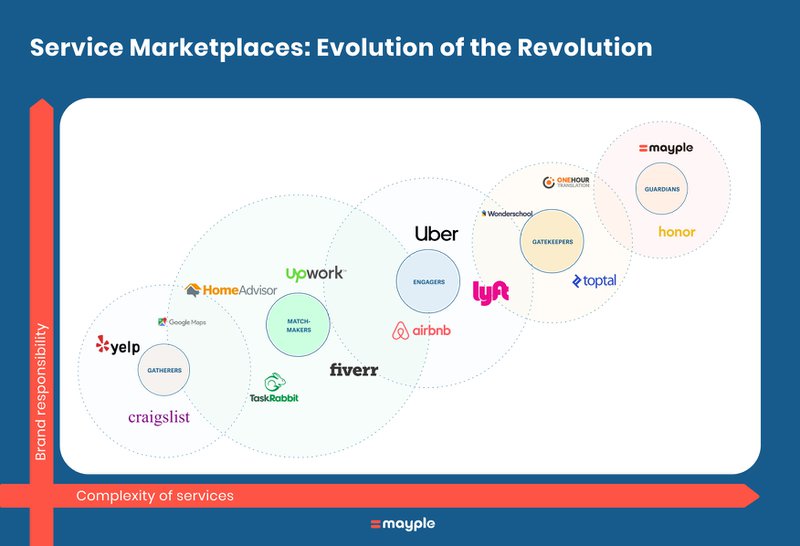Next generation service marketplaces take trust to a new level
As service marketplaces are poised to enter more complex services, the level of trust required to establish relationships is higher.
Published November 5, 2024

Service marketplaces are on the rise and provide us better access to the service economy. But as service marketplaces are poised to enter more complex industries and services, the level of trust required to establish relationships is higher, and so is the need to create a coherent customer experience and added value for both the supply and demand side.
We are all kids in a candy store
We live in an era where we can contact any person or company on earth from our smartphone. We can find a designer in Oslo who creates beautiful crafts and order one of their pieces, knowing that it will be delivered all the way to London. We can purchase SEO services from a professional in Barcelona and have our company’s video created by a freelancer in New York.
Access to such a variety of services provides us with the same simultaneous thrill and over-stimulation experienced by kids in a candy store. It can be a lot, but boy, do we want it. This all started with the digital transformation of services and has brought us to an era of service marketplaces.
But with the wide variety of service possibilities at our eager fingertips, how can it be possible to manage them all and provide the best services to our own customers?
Traditional marketplace vs. managed marketplace
Marketplace platforms have drastically reshaped retail industries and consumer behavior. eBay, Amazon, Alibaba, Etsy and other digital marketplaces have cropped up, each enabling sellers and consumers to engage in one-stop shop transactional connections, regardless of their physical locations across the globe.
Each of these marketplaces offers a different level of service to its customer base, but all offer a comprehensive shopping experience that is simplified and easy to use, via an accessible platform. The consumer marketplaces tap into a distributed market where producers of products and services are ready to sell their wares to consumers all over the world much more powerfully than a traditional marketplace.
Managed marketplaces differentiate themselves by the level of added value they inject into the relationship created on their platform and by the service and support they provide to each side. In a sense, they empower both sides to create higher value for one another.
To demonstrate the differences, think about the difference between eBay and Amazon, Craiglist and Airbnb, Upwork and Toptal. Successful service marketplaces either transform current business models (like Uber did) or create a horizontal marketplace (like Fiverr did). The key to the success of these services marketplaces is their focus on matching between the buyers and sellers and creating features that improve the customer experience.
What is a service marketplace?
Although the basic functions of product and service marketplaces might seem the same, there are some fundamental differences between them, mostly as a result of the fact that in service marketplaces, the “goods” that are purchased are human skills and time.
So let's define the term.
A service marketplace is a website where private individuals, professionals, or companies can offer their services. Examples of online marketplaces for services are Fiverr, Upwork, and Thumbtack.
The added value created by a service marketplace itself, is critical to the success of the relationships it creates.
The talent economy in blooming. More and more talents are choosing to make their careers as freelancers or small agency owners.
Service marketplaces allow service buyers to connect with professionals from all types of fields and industries. Some redefine how we manage various aspects of our lives, from building IKEA furniture to driving from place to place in a city.
But, when talking about services provided to you by different people around the globe, “things” can get more increasingly complex. And by “things,” I am referring to the quality and frequency of actual services rendered.
This is because, with increased connectivity between people from remote locations comes enhanced risk for poor fit, sloppy results and even fraud.
Services we are used to acquiring in personal, face to face meetings and through high-touchpoint sales processes are suddenly being hawked online, where we cannot exert judgment based on body language, eye contact or a smile.
To some extent, the more we connect to people via digital marketplaces, the more our level of trust in these people is likely to erode.
What does trust have to do with it?
Initially, it’s actually more about risk than trust. When shopping for a smartphone case on AliExpress, we are willing to take a greater risk with our money than when looking for a service provider to handle our business marketing activities and access our business data. We are naturally more conservative regarding the level of risk we are willing to take for example with a real estate purchase on a marketplace like Zillow.
For marketplace businesses it's all about building trust. Why is it easier for an eCommerce business to launch quickly on a platform like Amazon then to grow their own site? Because Amazon has built trust with more than 1 billion customers. They already have their credit card saved on the platform and may even be an Amazon Prime member. They are bought in.
SMBs are finding themselves in a catch-22
One would think that the open access to different service providers would better position businesses, especially smaller businesses, to access services like never before. But when talking about B2B services, it’s not that simple.
Large enterprises mitigate the high risk of buying outsourced services, by purchasing high-end and expensive solutions, and by investing in their in-house management talent on a professional level.
Medium and small-sized businesses are also relying more and more on outsourced services, even with their core activities, due to their flexible needs and low access to talent - but this means they assume a much higher risk hiring service providers than they’re traditionally used to doing.
Here’s why.
First, they are outsourcing some of their core activities such as sales and marketing. Second, their limited budget means they can’t afford enterprise level solutions designed with a higher probability to achieve high performance.
Third, they lack the strong management and measurement mechanism to assure they get high performance from the services they buy. That keeps small and medium-sized businesses in an underdog position that is hard to step out from.
This is why everybody (including service marketplaces) loves talking about data. Data is the ultimate replacement to human intuition. Data provides us with reliability, while remaining completely devoid of any bias, enabling buyers to regain trust in the service providers they ultimately choose to work with. But although data by itself is unbiased, how you use this data is can be very, very biased.
To ensure data reliability and trust, a few hard questions must most certainly be raised:
The first group of questions is about judgment:
Who sets the standard?
- Who decides what is considered to be a high or low service level?
- How do you measure success?
Who is knowledgeable about best value and fit?
- Who can help us identify the service provider that we will bring us, as unique individuals or businesses, the best value for our money?
- How will you know that they will help you grow your business?
The second group of questions is about responsibility:
Who is held responsible?
- Who is going to be responsible for the quality of the services we buy?
- Who do we turn to in the event that the services rendered were less than satisfactory?
Who manages the working relationship?
- How can you manage multiple independent service providers and hold them to a unified scale of quality, so that they can achieve co-dependent goals?
Service marketplaces are on the rise, and while most of them succeed in providing us better access to the service economy, most of them do not provide full answers to the questions I mentioned above.
As service marketplaces are poised to enter more complex industries and services where the level of trust required to establish relationships is higher, they will have to answer most, if not all of these questions, or risk losing their status and their client base.
New generation of service marketplaces has arrived
Before describing next generation service marketplaces, and how they solve SMBs’ catch-22 in depth, let’s take a step back and try to map the evolution of these revolutionary solutions so far.
I used Li Jin and Andrew Chen’s chart as a starting point and added new axis levels and names for the different stages of the described evolution.
Complexity of services is a term that refers to services that require a high level of trust, as they are based on long term relationships - not on one-time transactions. For example, hiring a lawyer to handle your business’ legal issues is a much more complex service than hiring a technician to fix your washer.
Brand responsibility refers to the level of proactive support and the guarantee that the service marketplace brand provides both sides in a transaction. It is a function of the risk level involved in using the service.
When you talk about core business activities, having a trusted and unbiased third party who is responsible for the long-term relationship reduces the risk tremendously, while creating added value - a large investment in quality assurance and service operations to reduce risk to all sides involved.
Different service marketplaces offer their customers different levels of brand responsibility.
Gatherers
These are service marketplaces like Craigslist and Yelp, which gather a very wide variety of services and allow us to conveniently search for the ones that fit our basic requirements. These kinds of service marketplaces provide consumers with a convenient way to search within the frameworks of a fully transactional relationship.
Matchmakers
Service marketplaces like Fiverr and TaskRabbit are prime examples of are making an effort to customize the list of the services provided with better filters and reviews, to help judge some aspects of service quality in the eyes of other past users, within the framework of a transactional relationship.
Engagers
Uber and Airbnb are both examples of service marketplaces that provide a higher level of service and engagement. The level of responsibility these two brands pledge towards their supply and demand sides is exceptional.
An Uber passenger is Uber’s client and therefore a low service level will lead to the customer receiving a refund from Uber. An Airbnb host will enjoy a higher confidence level with Host Guarantee property damage protection. Both brands assume higher responsibility levels over the services provided through their platforms.
Food delivery apps like GrubHub have added features like a rating system, order management, request scheduling, and a marketplace feature that generates monthly invoices. They've truly automated areas these areas of the user journey to provide a superior user experience to their consumers and suppliers.
Gatekeepers
These are service marketplaces that set a higher standard in their industry, by defining the screening and qualification methods and quality assurance measurement scales to be used. Brands like Wonderschool provide access to high-end services based on a thorough screening process, that was traditionally very complicated and expensive to execute independently.
Translate this to a B2B service marketplace and you’ll discover the beginnings of a catch-22 breach for SMBs, as it enables a management capability that doesn’t result in much higher fee being charged. B2B markeplaces have had a very high barrier of entry and their marketplace model is slowly crumbling.
What about the next-gen managed service marketplace?
The Guardians
Guardians take gatekeeping to the next level, providing fully managed service marketplaces brands can trust. One great example, Mayple, starts by screening their marketing service providers using a thorough, data-based vetting process and continues to make sure that businesses get high level results and services throughout their relationships with their independent marketers. They also provide complete transparency to the users into the process, the data, and the actual work being done on each project.
Solving pain points and leveling the playing field
Mayple is a prime example of an end-to-end solution that the new generation of B2B service marketplaces can provide businesses. These kinds of service marketplaces set an industry standard regarding the quality of services and expected performance, while taking a much broader and proactive responsibility for the actual quality delivered to the customer, in a way that generates long-term relationships and trust, as a customer-first marketing strategy.
This allows SMBs to finally enjoy the best of both worlds They obtain full access to high-end services from the service providers, as well as from the brand itself, in a flexible and relatively cheap way, thanks to the marketplace scale.
The hybrid approach of a technology-based service and high level of responsibility is enabling the benefits of high-touchpoint connections to be produced into a scalable solution. It is here that we might experience a shift between the short-term transactional relations we are used to seeing in the SaaS world, to the long-term relationship of a trusted B2B brand.
On the other hand, the service providers get a lot of advantages too (besides having access to new clients). They get to enjoy back-office services like booking management, payment processing, and onboarding new clients. All of that is done by the marketplace. They also get to enjoy the network effects of a referral program if the marketplace has one.
Are you ready for the next generation of marketplaces?
FAQs
What are the different types of marketplaces?
There are several types of marketplaces. There are the gatherers - they are job boards or review aggregators like Craigslist or Yelp, matchmakers like Fiverr and TaskRabbit, Engagers like Uber and Airbnb, and Gatekeepers/Guardians like Mayple
What is an example of a marketplace?
Uber and Airbnb are both examples of service marketplaces that provide a higher level of service and engagement. The level of responsibility these two brands pledge towards their supply and demand sides is exceptional. An Uber passenger is Uber’s client and therefore a low service level will lead to the customer receiving a refund from Uber. An Airbnb host will enjoy a higher confidence level with Host Guarantee property damage protection. Both brands assume higher responsibility levels over the services provided through their platforms.
What is the difference between a marketplace and a platform?
A platform connects buyers and sellers but is typically not involved with the sale itself. A marketplace plays a direct role in the transaction itself.
What is a service marketplace?
A service marketplace is a website where private individuals, professionals, or companies can offer their services. Examples of online marketplaces for services are Fiverr, Upwork, and Thumbtack.





